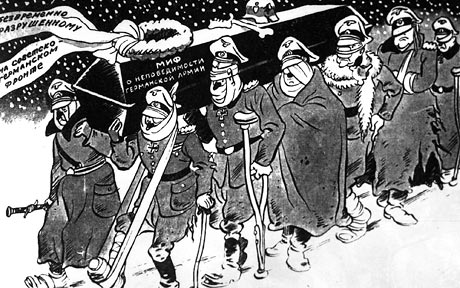His cartoons covered a long stretch of history, but here we mainly stress on his cartoons during WW2.....We present his collection of cartoons called "Hitler and his Gang"
Efimov had an abundance of wit and was exceptionally well read, which gave his drawings a stinging conceptual punch. A telling example is a Efimov drawing from World War II described by Vladimir Mochalov, a fellow cartoonist and artistic director of the famous satirical magazine, Krokodil: “Boris Efi mov published a famous cartoon with the caption: ‘A True Aryan is Tall’, and he drew a small, scrawny Goebbels; ‘A True Aryan is Fit’, and he drew a fat Goering; and, ‘A True Aryan is Blond’, for which he drew Hitler with his black bangs. This was an absolutely timely, witty drawing, a classic political cartoon that you might call: aiming straight between the eyes.” In the bleak early years of the war, cartoons like this one played a critical role in maintaining morale. Efimov himself says about those cartoons, “I have an entire folder of letters from frontline soldiers who thanked me for those cartoons, who wrote me, ‘Draw their faces even funnier, because then it’s more fun to pull the trigger.’”
http://www.passportmagazine.ru/article/1565/
WHO WAS BORIS YEFIMOV (ALSO SPELT EFIMOV)?
“Fist.” An iron fist labeled NKVD (the secret police) squeezes a handful of midgets, among them Trotsky, Bukharin, and Rykov. The bodies of the victims end in a single tail that forms a swastika. Cartoon by Boris Efimov included in his memoirs.
Soviet political caricaturist and memoirist who was, for some time, the world's oldest living Jew. During his heyday, which lasted from the 1920s to the fall of the Soviet Union, Boris Efimov was an obedient satirist whose brilliant cartoons depicted Soviet policy on the pages of its major newspapers and magazines: Izvestiia, Pravda, and Krokodil.
His career was interrupted for several years following the arrest in 1938 of his brother, the writer Mikhail Kol’tsov, who was shot as an enemy of the people in 1940. Efimov was devoted to his brother, trying to secure his release even after—unbeknownst to him—Kol’tsov had been killed. Either because he was valuable to Stalin or because of the peculiar randomness of the Soviet Terror, Efimov himself was spared and brought back to his former position, at first anonymously.
He was the recipient of numerous Soviet medals and was named a member of the Academy of Arts. In addition to many collections of cartoons, he published four volumes of memoirs, beginning at age 70 and ending at 100.
Efimov was born in Kiev, where his father had an official document allowing him to engage in shoe repair. Soon after, however, the family left for Belostok (Białystok), where Efimov and his older brother began their schooling. Efimov did not go to art school. The instability of those revolutionary years put him first in Khar’kov (1917) and then, the next year, in Kiev. His first caricature, of the poet Aleksandr Blok, appeared in 1918, and his earliest political cartoon a year later. By 1922 he was in Moscow, where, helped by his brother's ties as well as his own formidable talent, he became associated with the Soviet Union's two major newspapers Pravda and Izvestiia, and the satirical magazines Krokodil (founded in 1922) and Chudak (1928–1930; Efimov began in its second year).
Efimov’s subjects were the evil-doing enemies of Soviet domestic and international policy. In terms of foreign policy, these were Wall Street capitalists and leaders of European governments, later including NATO. Western opponents were personified variously, and often wittily: the American capital churned out dollars, the Statue of Liberty was caged or in chains, the bourgeoisie of all Western countries were a combination of potbellied and malevolent.
This is how Yefimov showed "The Invincible German Army" after it took a hiding in the Battle of Moscow in December 1941
Hitler and the Nazi leadership were unending targets throughout World War II, and also during the Nuremberg Trials. Efimov’s drawings from Nuremberg show the defendants' heads emerging from finely drawn bodies of insects and rodents.
At the time of the 1967 and 1973 wars, Efimov satirized Israel. His cartoons from the period personify Israel as a burly, gun-toting aggressor (see image). In some cartoons, the Star of David merges with a skull and crossbones (see image). But Efimov steered clear of the Jewish physical stereotypes and Nazi imagery associated with anti-Israel cartoons in the Soviet press, even though he often drew on Nazi symbolism in his caricatures of Western European leaders.




























0 Comments:
Yorum Gönder